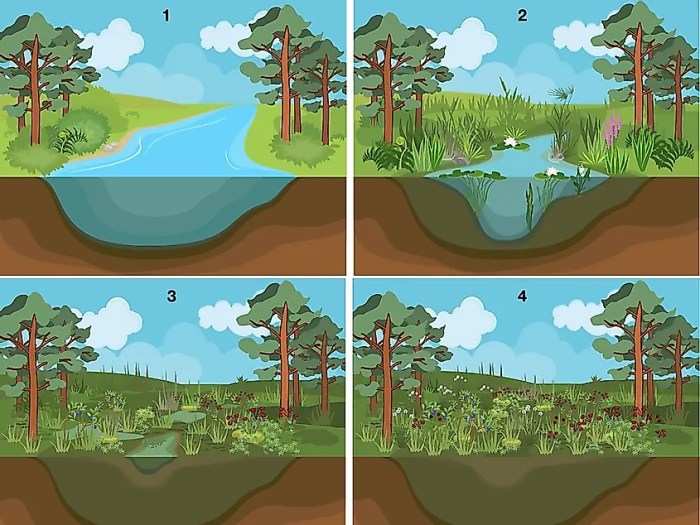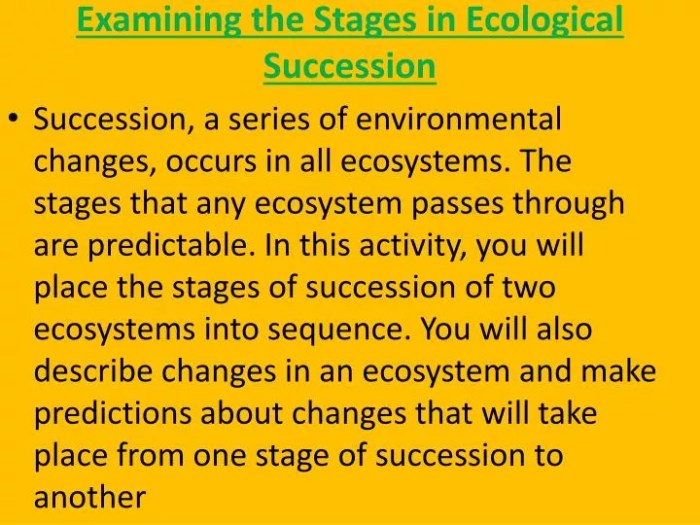Examining the stages in ecological succession in a pond reveals the intricate processes that shape aquatic ecosystems. From the establishment of pioneer species to the development of a stable climax community, this dynamic journey unveils the remarkable resilience and adaptability of nature.
Ecological succession is a gradual and predictable change in the composition of species within an ecosystem over time. In a pond, this process unfolds in distinct stages, each characterized by unique assemblages of organisms and environmental conditions.
Pioneer Species: Examining The Stages In Ecological Succession In A Pond

Pioneer species are the first organisms to colonize a bare area. They are typically small, fast-growing, and have a high tolerance for harsh conditions. Pioneer species help to create a more stable environment for other organisms to colonize. Examples of pioneer species found in ponds include algae, bacteria, and small aquatic plants.
Adaptations of Pioneer Species
Pioneer species have a number of adaptations that enable them to colonize bare areas. These adaptations include:
- Small size: Pioneer species are typically small in size, which allows them to easily colonize small, open areas.
- Fast growth rate: Pioneer species have a fast growth rate, which allows them to quickly establish a foothold in a new area.
- High tolerance for harsh conditions: Pioneer species are able to tolerate a wide range of harsh conditions, such as extreme temperatures, low nutrient levels, and high levels of pollution.
Intermediate Species

Intermediate species are the organisms that colonize an area after the pioneer species have established a more stable environment. Intermediate species are typically larger and longer-lived than pioneer species, and they have a lower tolerance for harsh conditions. Examples of intermediate species found in ponds include aquatic insects, small fish, and larger aquatic plants.
Characteristics of Intermediate Species
Intermediate species have a number of characteristics that distinguish them from pioneer species. These characteristics include:
- Larger size: Intermediate species are typically larger in size than pioneer species, which allows them to compete more effectively for resources.
- Longer lifespan: Intermediate species have a longer lifespan than pioneer species, which allows them to establish a more permanent presence in an area.
- Lower tolerance for harsh conditions: Intermediate species have a lower tolerance for harsh conditions than pioneer species, which means that they are more likely to be displaced by pioneer species in areas with harsh conditions.
Climax Community

The climax community is the final stage of ecological succession. The climax community is a stable, self-sustaining community that is dominated by long-lived, large organisms. Examples of climax communities found in ponds include mature forests, coral reefs, and grasslands.
Factors that Contribute to the Establishment of the Climax Community, Examining the stages in ecological succession in a pond
A number of factors contribute to the establishment of the climax community. These factors include:
- Climate: The climate of an area can play a major role in determining the type of climax community that will develop. For example, in temperate climates, the climax community is typically a forest, while in tropical climates, the climax community is typically a rainforest.
- Soil conditions: The soil conditions of an area can also play a role in determining the type of climax community that will develop. For example, in areas with well-drained soils, the climax community is typically a forest, while in areas with poorly-drained soils, the climax community is typically a wetland.
- Disturbances: Disturbances can play a role in resetting the successional process. For example, a fire can destroy a forest and create a new opportunity for pioneer species to colonize the area.
FAQ Section
What is ecological succession?
Ecological succession is the gradual and predictable change in the composition of species within an ecosystem over time.
What are the stages of ecological succession in a pond?
The stages of ecological succession in a pond include the pioneer stage, intermediate stage, and climax community stage.
What are pioneer species?
Pioneer species are the first organisms to colonize a bare or disturbed area and initiate the process of ecological succession.
What is a climax community?
A climax community is the final and most stable stage of ecological succession, characterized by a diverse assemblage of species that are well-adapted to the local environmental conditions.